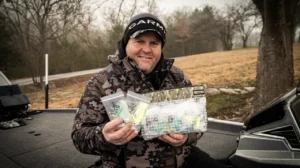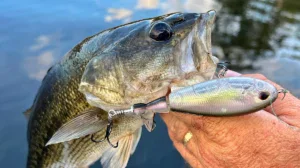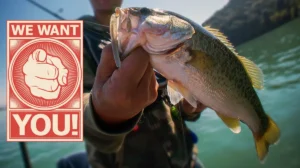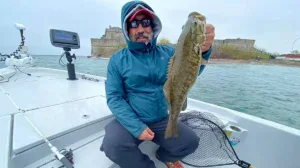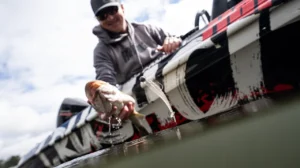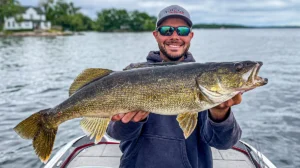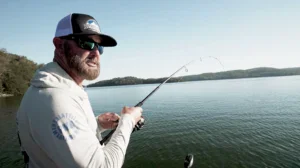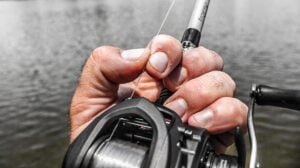Though bass can be caught shallow in the summer as well, it’s common knowledge that a large portion of the population moves deep this time of the year to escape the sweltering heat. The surface temps have risen into the upper 80s and even 90s in many places, and the bass will spend a portion of that time out in deeper waters.
Thus, it’s a good idea to look deep when bass fishing in the summer. But getting baits down deep accurately and efficiently can be a little tricky. Today, we’re going to talk about several ways to do this with a wide range of baits.
COUNT A BAIT DOWN
Let’s start with the basics. Counting a bait down is a common practice used by anglers to get baits down to somewhat accurate depth. The general rule of thumb is a foot per second. So for instance, if you’re throwing a swimbait out to target bass that are suspended 15 feet below the surface of the water, you should count about 15 seconds after the bait hits the water, before you start to reel the lure in.
This obviously varies, as a swimbait that weighs 1 ounce will fall at a rate much faster than one that weighs 1/4 ounce. But the concept of counting a bait down works the same way, once you determine the speed the bait falls through the the water, or the rate of fall (ROF). One good way to determine the ROF of a bait is to cast it into a known depth of water and then count how many seconds it takes for the bait to hit the bottom. Then, you can figure out how many feet per second the bait is falling and count your bait down to various depths.
LINE SIZE AND TYPE
It’s also widely known that fluorocarbon line sinks and braided line and monofilament lines float. If you didn’t know this, no worries, now you do. The obvious result of this knowledge is that fluorocarbon is going to be the preferred line choice almost anytime you’re trying to get a bait deep, with a baitcaster at least.
Since fluorocarbon sinks, it’s the best selection for football jigs, crankbaits, swimbaits and so on. But the type of line is only half the story here. You’re also going to want to use the smallest diameter fluorocarbon possible, as the smaller diameter creates less resistance and thus cuts through the water easier. This is extremely important when fishing a deep diving crankbait. Smaller 10-pound test is a great starting point with this technique, as baits can dive several feet deeper with this thin line as compared to a heavier pound test like 15 or 20.
Thinner diameter lines work better for baits that you want to let fall vertically at the end of a cast as well. Larger diameter lines again offer more resistance. So if you throw a 1/4-ounce shaky head out on 15-pound fluorocarbon as opposed to 12-pound test, the line will develop a bigger a bow in it and the bait will actually fall back towards where you are standing, instead of vertically to the fish or cover you’re trying to target. On the other hand, the smaller diameter would allow the bait to fall more vertically.
USING BRAID OUT DEEP
Though fluorocarbon works best for most baits when fishing deep, swapping over to a spinning reel changes things. It’s best to use a thin diameter braided line as your main line with a spinning reel attached to a fluorocarbon leader near the bait, for the low visibility. Even though most braided line floats, thin-diameter braid, like 15-pound test, cuts through the water with ease and eliminates very frustrating line twists that occur when spooling a spinning reel with straight fluorocarbon.
Braid also has a thinner diameter than fluoro, when looking at equivalent pound tests. This means you can get more braided line than fluoro onto your spinning reel, increasing your range. Braided line also casts better, has more sensitivity and is more resistant to abrasions compared to fluoro. So when looking at using thin diameter braid on spinning reels, all of these positive characteristics outweigh the one negative of the braid’s slight tendency to float.

VERTICAL FISHING EFFICIENCY
One big thing to keep in mind when fishing vertically with a spinning rod out deep is the positioning of your rod. This is something that was first brought to my attention while watching two-time Progressive Bassmaster Angler of the Year Brandon Palaniuk fish a drop shot. Palaniuk would click the bail on his reel and begin to let his bait fall to a fish he saw below his boat on his graph, a common practice.
But in an effort to allow his bait to fall faster and straighter, Palaniuk would point his rod tip to the water and raise his reel up in the air. Moving his rod into a vertical position like this reduced the friction of his line dragging across the eyes of his rod.
This difference might seem negligible from the surface. But when trying to hit a fish on the head in 30 feet of water, while fishing from a boat that’s coasting overhead and being rocked by wind and waves, this slight shift in the angle of the rod could increase your accuracy by 5 to 10 feet.
HORIZONTAL STALL OR FALL
We talked a little earlier about the rate of fall (ROF) of a bait, the speed a bait will fall through the water column. But there’s a similar term called rate of stall (ROS), which deals with the speed at which a bait can be retrieved through the water while maintaining a horizontal trajectory. The ROS is something very important to take into consideration when fishing something like a swimbait, spinnerbait, swim jig or vibrating jig out deep.
These types of baits are intended to be reeled at a fairly constant pace on a relatively horizontal path, and work best at targeting fish that are suspended near the bottom or higher in the water column. To get baits down to the bottom and keep them there efficiently, you’ll want to look for a bait that is heavy and/or has a low ROS.
To illustrate this idea, let’s look at three bait selections: a 1/2 ounce ChatterBait with a swimbait trailer, a 3/4-ounce ChatterBait with the same swimbait trailer and a 3/4-ounce ChatterBait with a craw-style trailer. The heavier 3/4-ounce bait with the swimbait trailer will fall faster than the 1/2-ounce ChatterBait with the same trailer. This outcome is fairly easy to predict, since the only difference is that one bait is heavier than the other.
But the ROS comes into play when looking at the two 3/4-ounce ChatterBaits, one rigged with a single paddle tail swimbait trailer while the other has a craw trailer with two appendages. The craw trailer, if it’s comparable in size to the swimbait, will create more resistance and thus a slower ROS as compared to the more streamlined swimbait trailer. So it will be easier to get the ChatterBait with the swimbait trailer deep, and keep it there. So the ChatterBait trailer matters when thinking deep.
MORE DEEP THOUGHTS
These are not the only things to consider when fishing deep. When cranking, for example, a headier crankbait with a tighter wobble and the perfect bill and pitch design will cast farther and dig deeper than a less optimal selection. But these baits are typically easy to pick out from a lineup due to their designation as deep diving (DD) crankbaits.
Yes, this is a conversation as a whole that could go much … well … deeper. But these are some pivotal points to consider when looking to target bass in deep water. And, if you implement them, they should help you become a better deep angler if you’re looking to grow your competency in this area.







